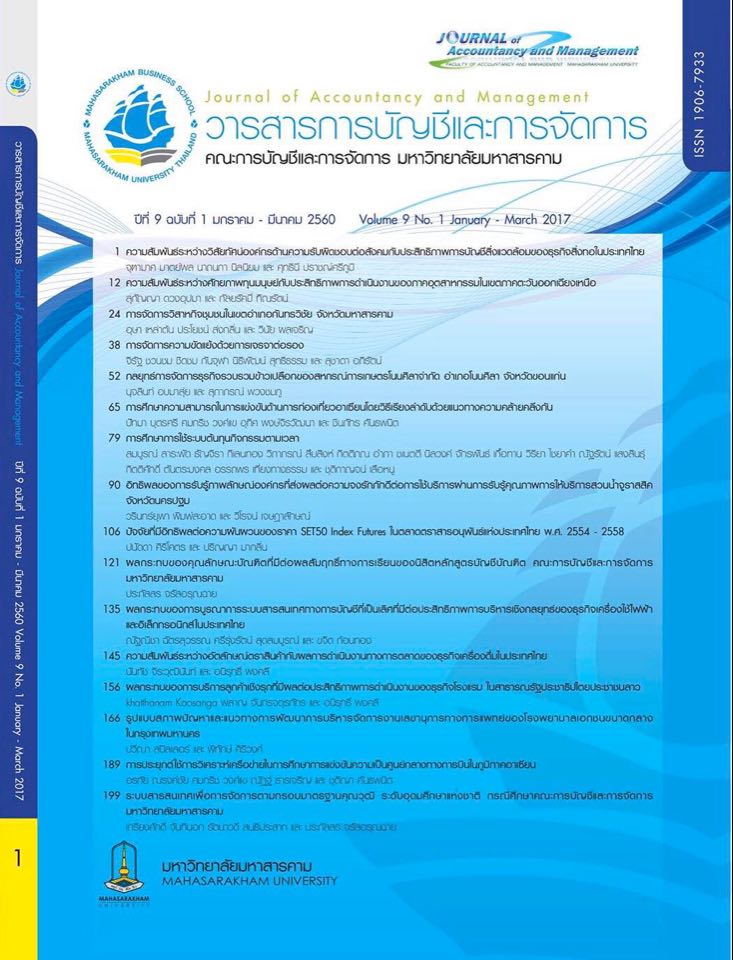การประยุกต์ใช้การวิเคราะห์เครือข่ายในการศึกษาการแข่งขัน ความเป็นศูนย์กลางทางการบินในภูมิภาคอาเซียน
Main Article Content
บทคัดย่อ
การขยายตัวของอุตสาหกรรมการบินในอาเซียนมีบทบาทสำคัญในการส่งเสริมการเคลื่อนย้ายปัจจัย
การผลิตและการเจริญเติบโตทางเศรษฐกิจภายในภูมิภาค การศึกษานี้มีวัตถุประสงค์เพื่อศึกษาความเป็นศูนย์กลางทางการบินและการแข่งขันสร้างเครือข่ายของอุตสาหกรรมการบินในอาเซียนโดยใช้ข้อมูลจำนวนเที่ยวบินต่อวันระหว่างท่าอากาศยานของประเทศในกลุ่มอาเซียน จำนวน 120 ท่าอากาศยาน จำนวน 5,093 เที่ยวบิน วัดดัชนี
ความเป็นศูนย์กลางโดยใช้โปรแกรม Ucinet 6.0 พบว่า ท่าอากาศยานนานาชาติ Soekarno-Hatta (CGK) ประเทศอินโดนีเซียมีค่าความเป็นศูนย์กลาง (Degree Centrality) สูงที่สุด ท่าอากาศยานนานาชาติ Kuala Lumpur (KUL) ประเทศมาเลเซีย มีค่าความเป็นศูนย์กลางความใกล้ชิด (Closeness Centrality) สูงที่สุด และ ท่าอากาศยานนานาชาติ Manila Ninoy Aquino (MNL) ประเทศฟิลิปปินส์ มีค่าคั่นกลาง (Betweenness Centrality) มากที่สุด สนามบินที่มีการแข่งขันการสร้างเครือข่ายมากที่สุดได้แก่ ท่าอากาศยานนานาชาติ Changi (SIN) ประเทศสิงคโปร์ การศึกษาปัจจัยที่มีอิทธิพลต่อค่าความเป็นศูนย์กลางของท่าอากาศยานในทิศทางเดียวกัน ได้แก่ ปริมาณเที่ยวบินที่ท่าอากาศยานต่อปี และอายุของท่าอากาศยาน ส่วนในทิศทางตรงข้าม คือ ท่าอากาศยานที่ดำเนินงานโดยรัฐบาล ส่วนการศึกษาปัจจัยที่มีอิทธิพลต่อระดับการแข่งขันที่วัดจากค่าความแตกต่างของค่าความเป็นศูนย์กลางเครือข่ายของสายการบินที่ท่าอากาศยาน พบว่าปัจจัยที่ส่งผลในทิศทางเดียวกันได้แก่ ปริมาณสายการบินที่ถือเอาท่าอากาศยานเป็นศูนย์กลางทางการบิน ส่วนในทางตรงข้าม ได้แก่ จำนวนผู้มาใช้บริการท่าอากาศยานต่อปี และท่าอากาศยานที่ดำเนินงานโดยรัฐบาล ผลการศึกษานี้สามารถนำไปใช้เป็นแนวทางในการเพิ่มศักยภาพในการเป็นศูนย์กลางทางการบินของภูมิภาค
Downloads
Article Details
บทความที่ได้รับการตีพิมพ์เป็นลิขสิทธิ์ของวารสารการบัญชีและการจัดการ
ข้อความที่ปรากฏในบทความแต่ละเรื่องในวารสารวิชาการเล่มนี้เป็นความคิดเห็นส่วนตัวของผู้เขียนแต่ละท่านไม่เกี่ยวข้องกับมหาวิทยาลัยมหาสารคาม และคณาจารย์ท่านอื่นๆในมหาวิทยาลัยฯ แต่อย่างใด ความรับผิดชอบองค์ประกอบทั้งหมดของบทความแต่ละเรื่องเป็นของผู้เขียนแต่ละท่าน หากมีความผิดพลาดใดๆ ผู้เขียนแต่ละท่านจะรับผิดชอบบทความของตนเองแต่ผู้เดียว
เอกสารอ้างอิง
เสรี พงศ์พิศ. เครือข่าย:ยุทธวิธีเพื่อประชาคมเข้มข้น ชุมชนเข้มแข็ง, กรุงเทพฯ:สถาบันส่งเสริมวิสาหกิจชุมชน, 2548.
Adler, N. and K. Smilowitz Hub-and-spoke network alliances and mergers: Price-location competition in the airline industry.Transportation Research Part B: Methodological, 2007; 41(4), 394-409.
Barros, C. P. and P., Wanke., An analysis of African airlines efficiency with two-stage TOPSIS and neural networks. Journal of Air Transport Management, 2015; 44–45, 90-102.
Fageda, X. and R. Flores-Fillol., A note on optimal airline networks under airport congestion. Economics Letters, 2015; 128, 90-94.
Jantachalobon, N., Vanichkobchinda, P. and Suthikarnnarunai, N., Airline Network Analysis of ASEAN International Airport Region. The Open Transportation Journal, 2014; 8: 19-25
International Air Transport Association., Air passenger monthly analysis. Retrieved May 15, 2015, from https://www.iata.org/publications/economics/Pages/Air-Passenger-Monthly-Analysis.aspx.
Lin, M. H. and B. Mantin., Airport privatization in international inter-hub and spoke networks.Economics of Transportation, 2015.
Pels, E., Network competition in the open aviation area. Journal of Air Transport Management, 2009; 15(2), 83-89.
Redondi, R., P. Malighetti. And Paleari S., Hub competition and travel times in the world-wide airport network. Journal of Transport Geography, 19(6), 2011; 1260-1271.
Takebayashi, M., Multiple hub network and high-speed railway: Connectivity, gateway, and airport leakage. Transportation Research Part A: Policy and Practice, 2015; 79, 55-
Wasseman, S and Faust, K., Social network analysis: Methods and applications. New York, Cambridge University press, 1994.


